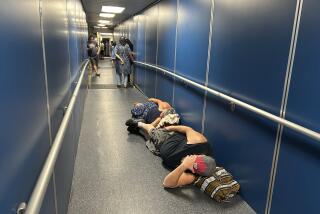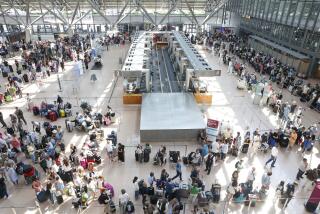News Web Sites Clogged in Aftermath
- Share via
Like more than half of America’s Internet users, Irvine resident Karen Connelly gets most of her news from the Web.
But Tuesday, the network designed to survive a nuclear war failed the 28-year-old software programmer as news Web sites across the country collapsed under the strain of millions of visitors desperate for information.
“I’ve never thought I needed a TV,” said Connelly, who had no clue about a terrorist attack until her brother called from Brooklyn. “I can’t believe how wrong I was. I’m going out and buying one today.”
News sites belonging to some of the nation’s largest and most trusted media outlets--including CNN, New York Times, Los Angeles Times, MSNBC and Yahoo--were all but inaccessible in the hours immediately after attacks on the World Trade Center and Pentagon.
The problem was purely technical--too many people wanted to know what was going on--but it highlights the weaknesses of a medium not ready to compete with the reach and immediacy of television and radio.
Traffic at some sites increased as much as 40 times over daily averages, straining the powerful computers that route data.
“It’s like those million kids in England who jumped up and down and made an earthquake last week,” said Jon Rochmis, content editor for Wired News. “Whenever everybody tries to do exactly the same thing all at once, things can break.”
But the Internet also revealed its resiliency. As news sites struggled to keep services running, Webmasters around the world offered to host material in an effort to prevent online bottlenecks.
By midmorning, many Web sites were operating at normal speeds as producers scaled back graphics and videos, focusing instead on easy-to-transmit text.
The Internet established itself as a source of breaking news during the Whitewater investigation into Bill Clinton’s Arkansas land deals, when users were able to search reams of documents online--often as quickly as professional journalists could.
That personalization is what makes the Internet an attractive source of news, but it’s also why online traffic can slow to a crawl as host computers scramble to fill thousands of individual requests per minute.
In much the same way as CNN established itself as the definitive source of information during the Gulf War, many online outlets brag that the Internet was poised to quash old-world media.
Not yet. Frustrated by online delays, millions of people instead tuned to television and radio stations.
An estimated 125 million Americans use the Internet. More than half that number use the Web to get news, according to the Pew Research Center for the People and the Press.
They want scoops, say industry watchers, and they know they can get them online. The terrorist attack in New York was an ideal story for the Net, a medium geared for immediacy. The Web, though, had never experienced this sudden, immediate demand for information.
CNN relies on banks of computer servers--powerful machines that house the company’s Web sites--and keeps backup servers in reserve, just in case one of its primary machines breaks.
After news of the crisis in New York hit, CNN’s computers were overwhelmed with millions of online consumers searching for stories. Officials at CNN.com rushed to triple its computer capacity and streamline its Web pages to make them smaller.
Mitch Gelman, CNN.com’s executive producer, said the site was quickly overwhelmed after its first story on the attacks went online. “Within 10 minutes, we were unable to service the volume of requests,” he said. “On a normal day, we can easily service up to 6 million visitors.”
Each minute, hundreds of thousands of people simultaneously were trying to get on CNN.com, which is a subsidiary of the AOL Time Warner-owned CNN cable channel. The site saw record traffic, hitting 9 million page views an hour since the tragedy occurred, compared with ordinary volume of 11 million page views a day.
“We’ve never seen anything like this,” said Gelman, who said the last time things got this busy on the Web site was when people were hungry for 2000 election results.
The Internet community rushed to fill the void and offered assistance, Gelman said. For instance, a company in Italy and several businesses in the United States put their excess Internet capacity at CNN’s disposal.
But it was the individual members of the global online community that filled the void. They did it by turning to each other--for information, for debate and for comfort.
Jeff Bates, a 25-year-old who helps run the online community site Slashdot.org, was booking airline tickets when he learned of the tragedy. “I was on the phone with a Northwest ticketing agent and she says, ‘Boy, it’s going to be a busy day,’ ” Bates said. “I had no idea what she was talking about.”
Like a small-town gathering in the corner coffee shop, frustrated Internet users flocked to Slashdot on Tuesday to swap tips.






